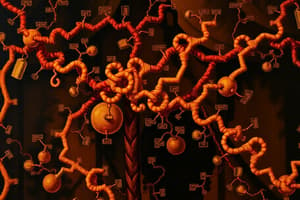Podcast
Questions and Answers
Which of the following represents a perspective for reviewing metabolic pathways, according to the text?
Which of the following represents a perspective for reviewing metabolic pathways, according to the text?
- Market value of products
- Genetic modification potential
- Pathway reaction steps (correct)
- Environmental impact
In glycolysis, which of the following conversions requires energy input?
In glycolysis, which of the following conversions requires energy input?
- 1,3-bisphosphoglycerate to 3-phosphoglycerate
- Triose phosphates to pyruvate
- Phosphoenolpyruvate to pyruvate
- Glucose to triose phosphates (correct)
What is the primary role of hexokinase in the context of glycolysis?
What is the primary role of hexokinase in the context of glycolysis?
- To regenerate NAD+
- To phosphorylate glucose, trapping it inside the cell (correct)
- To isomerize glucose 6-phosphate
- To cleave fructose 1,6-bisphosphate
Why is the conversion of glucose to glyceraldehyde 3-phosphate an important step in glycolysis?
Why is the conversion of glucose to glyceraldehyde 3-phosphate an important step in glycolysis?
Which enzyme catalyzes the conversion of glucose 6-phosphate to fructose 6-phosphate?
Which enzyme catalyzes the conversion of glucose 6-phosphate to fructose 6-phosphate?
What is the role of phosphofructokinase (PFK) in glycolysis?
What is the role of phosphofructokinase (PFK) in glycolysis?
What products are formed by the action of aldolase on fructose 1,6-bisphosphate (F1,6-BP)?
What products are formed by the action of aldolase on fructose 1,6-bisphosphate (F1,6-BP)?
Which enzyme interconverts dihydroxyacetone phosphate (DHAP) and glyceraldehyde 3-phosphate (G3P)?
Which enzyme interconverts dihydroxyacetone phosphate (DHAP) and glyceraldehyde 3-phosphate (G3P)?
What is produced during the glyceraldehyde 3-phosphate dehydrogenase reaction?
What is produced during the glyceraldehyde 3-phosphate dehydrogenase reaction?
What is the function of phosphoglycerate kinase in glycolysis?
What is the function of phosphoglycerate kinase in glycolysis?
During glycolysis, what is the role of phosphoglyceromutase?
During glycolysis, what is the role of phosphoglyceromutase?
What role does enolase play in glycolysis?
What role does enolase play in glycolysis?
What is the function of pyruvate kinase?
What is the function of pyruvate kinase?
What is the primary function of the pyruvate dehydrogenase complex (PDC)?
What is the primary function of the pyruvate dehydrogenase complex (PDC)?
Within the pyruvate dehydrogenase complex (PDC), what is the role of thiamine pyrophosphate (TPP)?
Within the pyruvate dehydrogenase complex (PDC), what is the role of thiamine pyrophosphate (TPP)?
What is the function of dihydrolipoyl transacetylase in the pyruvate dehydrogenase complex (PDC)?
What is the function of dihydrolipoyl transacetylase in the pyruvate dehydrogenase complex (PDC)?
What is the role of dihydrolipoyl dehydrogenase in the pyruvate dehydrogenase complex (PDC)?
What is the role of dihydrolipoyl dehydrogenase in the pyruvate dehydrogenase complex (PDC)?
How is glycolysis regulated to ensure that cells do not deplete blood glucose unnecessarily?
How is glycolysis regulated to ensure that cells do not deplete blood glucose unnecessarily?
What role does fructose 2,6-bisphosphate (F2,6-BP) play in the regulation of glycolysis?
What role does fructose 2,6-bisphosphate (F2,6-BP) play in the regulation of glycolysis?
During exercise, how does adenosine monophosphate (AMP) influence glycolysis?
During exercise, how does adenosine monophosphate (AMP) influence glycolysis?
How do ATP and citrate affect glycolysis?
How do ATP and citrate affect glycolysis?
How does fructose 1,6 bisphosphate regulate pyruvate kinase?
How does fructose 1,6 bisphosphate regulate pyruvate kinase?
How is pyruvate kinase regulated in fasting conditions?
How is pyruvate kinase regulated in fasting conditions?
How is pyruvate dehydrogenase (PDH) regulated by covalent modification?
How is pyruvate dehydrogenase (PDH) regulated by covalent modification?
What stimulates PDH phosphatase, leading to the reactivation of pyruvate dehydrogenase (PDH)?
What stimulates PDH phosphatase, leading to the reactivation of pyruvate dehydrogenase (PDH)?
Under anaerobic conditions, why is the capacity to recycle NADH back to NAD+ important?
Under anaerobic conditions, why is the capacity to recycle NADH back to NAD+ important?
How does the liver respond to conditions of excess NADH or pyruvate?
How does the liver respond to conditions of excess NADH or pyruvate?
What adaptation do fast-twitch muscle fibers have to support high rates of glycolysis?
What adaptation do fast-twitch muscle fibers have to support high rates of glycolysis?
Why do red blood cells (RBCs) rely entirely on anaerobic metabolism for energy?
Why do red blood cells (RBCs) rely entirely on anaerobic metabolism for energy?
What property distinguishes glucokinase from hexokinase?
What property distinguishes glucokinase from hexokinase?
What is the significance of glucokinase being present in pancreatic B cells?
What is the significance of glucokinase being present in pancreatic B cells?
How does the cellular compartmentation of glycolysis and the PDH pathway contribute to their regulation?
How does the cellular compartmentation of glycolysis and the PDH pathway contribute to their regulation?
Which of the following is true regarding anaerobic conditions and lactate?
Which of the following is true regarding anaerobic conditions and lactate?
How is glucose 6-phosphate (G6P) related to gluconeogenesis?
How is glucose 6-phosphate (G6P) related to gluconeogenesis?
What role does DHAP play in triglyceride and phospholipid metabolism?
What role does DHAP play in triglyceride and phospholipid metabolism?
How is pyruvate significance regulated?
How is pyruvate significance regulated?
What is the role of acetyl-CoA?
What is the role of acetyl-CoA?
What is Lactic Acidosis?
What is Lactic Acidosis?
Why does increase NADH result in elevated levels of lactate?
Why does increase NADH result in elevated levels of lactate?
What leads to pyruvate kinase deficiency?
What leads to pyruvate kinase deficiency?
What results from pyruvate dehydrogenase deficiency?
What results from pyruvate dehydrogenase deficiency?
What is Arsenate poisoning and who is it most damaging to?
What is Arsenate poisoning and who is it most damaging to?
How does Arsenite poisoning affect the body?
How does Arsenite poisoning affect the body?
Flashcards
Glycolysis
Glycolysis
Series of reactions converting glucose to pyruvate.
Pyruvate Oxidation
Pyruvate Oxidation
Conversion of pyruvate to acetyl-CoA.
PFK-1
PFK-1
First committed step of glycolysis
Pyruvate Kinase Regulation
Pyruvate Kinase Regulation
Signup and view all the flashcards
PDH Kinase
PDH Kinase
Signup and view all the flashcards
Anaerobic Glycolysis
Anaerobic Glycolysis
Signup and view all the flashcards
Glucokinase
Glucokinase
Signup and view all the flashcards
G6P
G6P
Signup and view all the flashcards
Lactic Acidosis
Lactic Acidosis
Signup and view all the flashcards
Arsenate Poisoning
Arsenate Poisoning
Signup and view all the flashcards
Arsenite Poisoning
Arsenite Poisoning
Signup and view all the flashcards
Pyruvate Kinase Deficiency
Pyruvate Kinase Deficiency
Signup and view all the flashcards
Hexokinase/Glucokinase
Hexokinase/Glucokinase
Signup and view all the flashcards
Phosphoglucose Isomerase
Phosphoglucose Isomerase
Signup and view all the flashcards
Phosphofructokinase
Phosphofructokinase
Signup and view all the flashcards
Aldolase
Aldolase
Signup and view all the flashcards
Triose Phosphate Isomerase
Triose Phosphate Isomerase
Signup and view all the flashcards
Glyceraldehyde-3-Phosphate Dehydrogenase
Glyceraldehyde-3-Phosphate Dehydrogenase
Signup and view all the flashcards
Phosphoglycerate Kinase
Phosphoglycerate Kinase
Signup and view all the flashcards
Phosphoglyceromutase
Phosphoglyceromutase
Signup and view all the flashcards
Enolase
Enolase
Signup and view all the flashcards
Pyruvate Kinase
Pyruvate Kinase
Signup and view all the flashcards
Regulated Reactions
Regulated Reactions
Signup and view all the flashcards
Unique Characteristics
Unique Characteristics
Signup and view all the flashcards
Interface with other Pathways
Interface with other Pathways
Signup and view all the flashcards
Related Diseases
Related Diseases
Signup and view all the flashcards
PDH Kinase Regulation
PDH Kinase Regulation
Signup and view all the flashcards
PDH Phosphatase
PDH Phosphatase
Signup and view all the flashcards
Lactate Formation Conditions
Lactate Formation Conditions
Signup and view all the flashcards
Glucokinase Function
Glucokinase Function
Signup and view all the flashcards
Glucokinase Purpose B Cells
Glucokinase Purpose B Cells
Signup and view all the flashcards
Interchange of pathways.
Interchange of pathways.
Signup and view all the flashcards
PDH Deficiency
PDH Deficiency
Signup and view all the flashcards
Study Notes
- These study notes cover glycolysis, pyruvate oxidation, and related metabolic concepts.
Five Perspectives for Learning Metabolism
- Intermediary metabolism involves interacting pathways that extract/store energy from fuel molecules.
- Learning metabolism can be consistently organized using five perspectives.
- Pathway reaction steps: Each reaction has unique substrates, products, enzymes, cofactors, and inhibitors.
- Regulated reactions: Hormones and/or metabolites regulate certain steps to control metabolite flow.
- Unique characteristics: Each pathway has unique functional aspects and contributions to metabolism.
- Interface with other pathways: Metabolic intermediates serve as substrates for alternate pathways, linking pathways.
- Related diseases: Enzyme deficiencies disrupt metabolite availability, leading to homeostasis imbalances.
Pathway Reaction Steps
Glycolysis - Glucose to Pyruvate
- Glycolysis converts glucose to pyruvate in two stages:
- Requires energy to convert glucose to triose phosphates (5 reactions), produces energy by converting triose phosphates to pyruvate (5 reactions).
Conversion of Glucose to Glyceraldehyde 3-Phosphate
- Glucose is phosphorylated by hexokinase (or glucokinase in the liver) using ATP to trap glucose inside the cell. This step is irreversible.
- Glucose 6-phosphate (G6P) is converted to fructose 6-phosphate (F6P) by phosphoglucose isomerase, moving the carbonyl group.
- F6P acquires another phosphate from ATP via phosphofructokinase, producing fructose 1,6-bisphosphate (F1,6-BP).
- F1,6-BP is cleaved by aldolase into dihydroxyacetone phosphate (DHAP) and glyceraldehyde 3-phosphate (G3P).
- DHAP is isomerized to G3P by triose phosphate isomerase, allowing two G3P molecules to form from one F1,6-BP.
Conversion of Glyceraldehyde 3-Phosphate to Pyruvate
- G3P is oxidized and phosphorylated by glyceraldehyde 3-phosphate dehydrogenase, producing 1,3-bisphosphoglycerate (1,3-BPG) and NADH using inorganic phosphate.
- A phosphate is transferred from 1,3-BPG to ADP by phosphoglycerate kinase, producing ATP and 3-phosphoglycerate (3PG). This is substrate-level phosphorylation.
- The phosphate group on 3PG is shifted to carbon 2 by phosphoglyceromutase to produce 2-phosphoglycerate (2PG).
- A molecule of water is removed from 2PG by enolase, producing phosphoenolpyruvate (PEP.)
- Fluoride inhibits enolase by binding with Mg++.
- PEP undergoes substrate-level phosphorylation of ADP via pyruvate kinase, yielding ATP and pyruvate. This is another substrate-level phosphorylation.
Pyruvate Oxidation - Pyruvate to Acetyl-Coenzyme A
- Pyruvate is transported into the mitochondrial matrix and oxidized by the pyruvate dehydrogenase complex (PDC), linking glycolysis to the citric acid cycle.
- Three steps produce acetyl-CoA and NADH.
- Pyruvate binds to thiamine pyrophosphate (TPP) on the pyruvate dehydrogenase (PDH) enzyme and is decarboxylated, releasing CO2.
- A hydroxyethyl group, with two carbons from pyruvate, remains bound to TPP.
- The hydroxyethyl group is transferred from TPP to lipoic acid by dihydrolipoyl transacetylase; lipoic acid is reduced, and the hydroxyethyl group is oxidized to an acetyl group.
- The acetyl group is transferred to CoA, producing acetyl-CoA, leaving lipoyl coenzyme in the reduced form.
- The reduced lipoyl coenzyme is oxidized by dihydrolipoyl dehydrogenase, using FAD as a coenzyme, which is reduced to FADH2. FADH2 reduces NAD+ to NADH.
Regulated Reactions
Regulation of Glycolysis
- Glycolysis is regulated at three points, each with a different function.
- Hexokinase (except in the liver) is allosterically inhibited by G6P, ensuring cells don't take up too much glucose, while glucokinase in the liver is not inhibited by G6P.
- Phosphofructokinase (PFK-1) controls G6P entry into glycolysis; when slowed, G6P is routed to glycogen synthesis/pentose phosphate pathway.
- Fructose 2,6-bisphosphate (F2,6-BP) stimulates PFK-1 in the liver when insulin levels are high. Elevated glucagon inhibits PFK-2, lowering F2,6-BP.
- Adenosine monophosphate (AMP) stimulates PFK-1 in muscle during exercise to restore ATP levels.
- ATP and citrate slow glycolysis when energy is abundant.
- Pyruvate kinase regulation controls PEP flow to pyruvate/gluconeogenesis.
- Pyruvate kinase is allosterically stimulated by F1,6-BP in well-fed conditions and inhibited by ATP and alanine during fasting.
Regulation of Pyruvate Oxidation
- The PDC is regulated by covalent modification of pyruvate dehydrogenase (PDH).
- PDH kinase inactivates PDH by phosphorylation with ATP. Reactivation occurs via PDH phosphatase.
- PDH kinase is stimulated by NADH and acetyl-CoA and is inhibited by pyruvate.
- PDH phosphatase is stimulated by Ca++ and insulin.
Unique Characteristics
Anaerobic Glycolysis
- The capacity to recycle NADH back to NAD+ anaerobically is important in several tissues.
Liver
- The conversion of pyruvate to lactate recycles NADH, allowing the liver to dispose of excess NADH or pyruvate.
- Lactate can be converted back to pyruvate or excreted.
- The net energy production of anaerobic glycolysis is 2 ATP per glucose molecule; no CO2 is produced.
Muscle
- Fast-twitch muscle fibers use glycolysis for rapid energy, containing high concentrations of lactate dehydrogenase.
Red Blood Cells
- Red blood cells (RBCs) lack mitochondria, relying entirely on anaerobic metabolism for energy.
Glucokinase Versus Hexokinase
- Glucokinase, the isoform in the liver, captures dietary glucose; its high Km minimizes glucose uptake during fasting, preventing hypoglycemia.
- Glucokinase is also present in pancreatic B cells.
- Hexokinase, the widely distributed isoform, has a low Km, allowing glucose entry into brain cells and RBCs under fasting.
Cellular Compartmentation
- Glycolysis occurs in the cytoplasm; the PDH pathway is in the mitochondrial matrix.
- Cells that rely on anaerobic glycolysis, like fast-twitch muscle fibers and RBCs, have few mitochondria.
Function of Glucokinase in B cells
- B cells contain glucokinase instead of hexokinase to prevent inappropriate insulin secretion. Elevated G6P signals insulin release when blood glucose rises.
Multienzyme Complexes
- The PDC exemplifies a multienzyme unit with coordinated function via geometric arrangement, preventing intermediate diffusion.
Energy Production
- ATP yield from glucose oxidation depends on O2 availability.
- Under aerobic conditions, complete conversion yields 36-38 ATP/glucose.
- Under anaerobic conditions, conversion yields 2 ATP/glucose.
Interface with Other Pathways
Glucose 6-Phosphate
- Because glucose 6-phosphate is also a product of gluconeogenesis, it serves as a substrate for glucose-6-phosphatase in the liver. The action of this enzyme releases free glucose into the bloodstream.
- Phosphoglucomutase provides for interchange between glycogen, galactose, and uronic acid metabolism.
Fructose 6-Phosphate
- F6P is the precursor for amino sugar synthesis.
Dihydroxyacetone Phosphate
- DHAP is converted to glycerol 3-phosphate, providing a source for triglyceride and phospholipid metabolism and carbons for gluconeogenesis.
Pyruvate
- Pyruvate is converted to oxaloacetate by pyruvate carboxylase for gluconeogenesis.
- Pyruvate is interconverted with alanine by alanine aminotransferase (alanine cycle) and with lactate (Cori cycle).
Acetyl-Coenzyme A
- Acetyl-CoA is a precursor for fatty acid synthesis and product of fatty acid oxidation, ethanol catabolism, and ketone body catabolism.
Related Diseases
Lactic Acidosis
- Lactic acidosis results from increased lactate in the blood:
- This is typically due to overproduction in the liver or skeletal muscle.
- Increased NADH (from hypoxia, respiratory distress, shock, or ethanol consumption) or increased pyruvate (from PDH deficiency or pyruvate carboxylase deficiency) can lead to lactic acidosis.
Pyruvate Kinase Deficiency
- Pyruvate kinase deficiency is the most common enzyme deficiency in glycolysis, severely reducing ATP production in RBCs, leading to hemolytic anemia.
Pyruvate Dehydrogenase Deficiency
- Deficiencies in PDC components increase lactate and cause lactic acidosis and reduced citric acid cycle activity, leading to myopathy and neuropathy.
Arsenate and Arsenite Poisoning
- Arsenate uncouples substrate-level phosphorylation by G3P dehydrogenase, eliminating ATP gain from anaerobic glycolysis.
Arsenite Poisoning
- Arsenite binds covalently to lipoic acid, preventing hydroxyethyl group transfer.
Studying That Suits You
Use AI to generate personalized quizzes and flashcards to suit your learning preferences.




